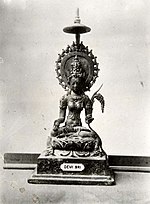A request that this article title be changed to Panakawan is under discussion. Please do not move this article until the discussion is closed. |
This article needs additional citations for verification. (October 2024) |
| This article is a part of the series on |
| Indonesian mythology and folklore |
|---|
 |
|
|


In Javanese wayang, the panakawan (Javanese: ꦥꦤꦏꦮꦤ꧀)[1] or punakawan (ꦥꦸꦤꦏꦮꦤ꧀)[2] are the clown servants of the hero. There are four of them – Semar, Petruk, Gareng (ꦒꦫꦺꦁ, Garèng),[3] and Bagong (ꦧꦒꦺꦴꦁ).[4] Semar is the personification of a deity, sometimes said to be the dhanyang (Javanese: ꦝꦚꦁ)[5] or guardian spirit of the island of Java. In Javanese mythology, deities can only manifest themselves as ugly or otherwise unprepossessing humans, and so Semar is always portrayed as short and fat with a pug nose and a dangling hernia.
His three companions are his adopted sons, given to Semar as votaries by their parents. Petruk is portrayed as tall and gangling with a long nose, Gareng as short with a club foot, and Bagong as obese.
The panakawan always appear in the second act of a wayang performance – pathet sanga – as servants to the hero of the story regardless of who that hero is.
Similar characters appear in other Indonesian wayang and theatrical traditions, including those of Bali and Sunda, under different names.[6][7]
The panakawan characters are generally much-loved by audiences who attend wayang plays in Indonesia and their appearance in the plays is usually greeted with laughter and anticipation.
- ^ Robson & Wibisono (2002:536)
- ^ Robson & Wibisono (2002:604)
- ^ Robson & Wibisono (2002:231)
- ^ Robson & Wibisono (2002:65)
- ^ Robson & Wibisono (2002:181)
- ^ "Mengenal 4 Tokoh Punakawan, Sangut, Delem, Tualen, dan Merdah dalam Pewayangan Bali | Kintamani.id" (in Indonesian). 2019-08-27. Retrieved 2024-09-13.
- ^ "Makna Filosofis Punakawan pada Wayang Golek: dari Semar, Cepot, Dawala, hingga Gareng". NU Online (in Indonesian). Retrieved 2024-09-13.
